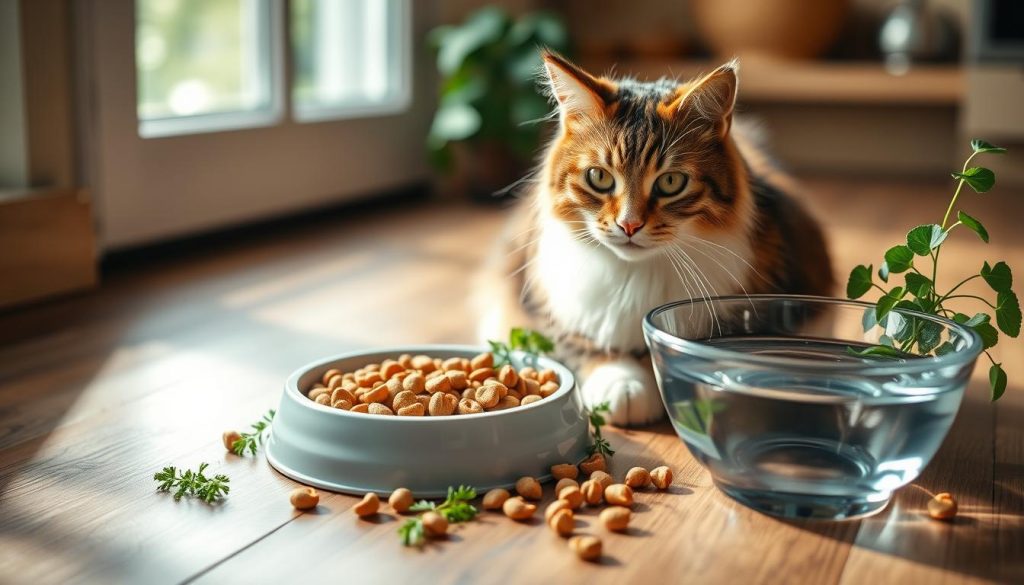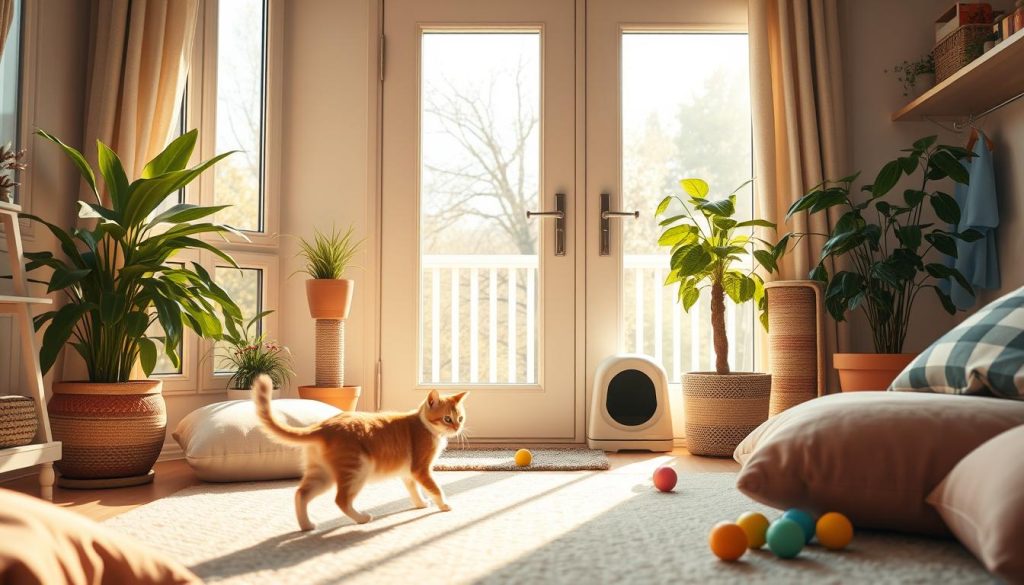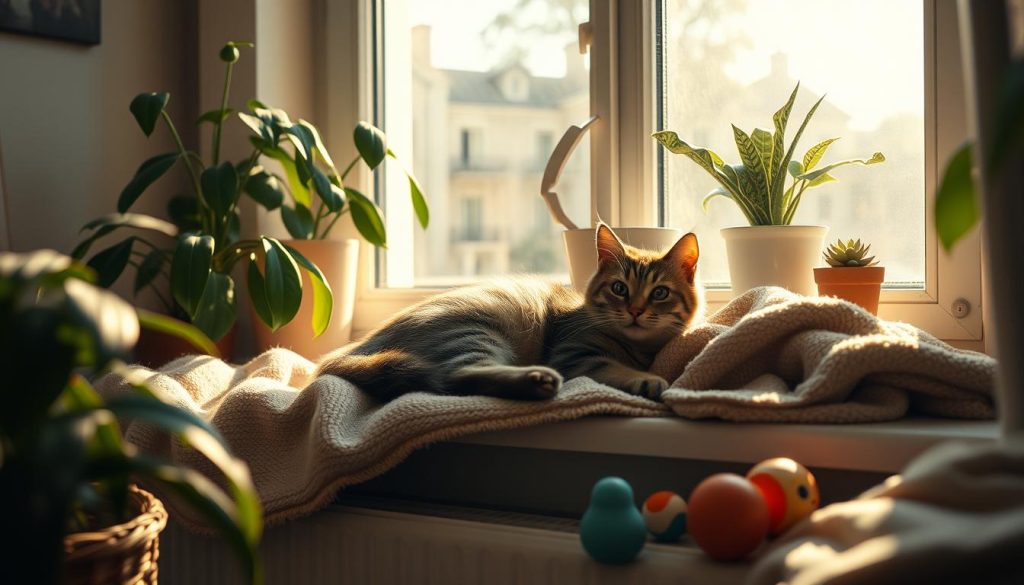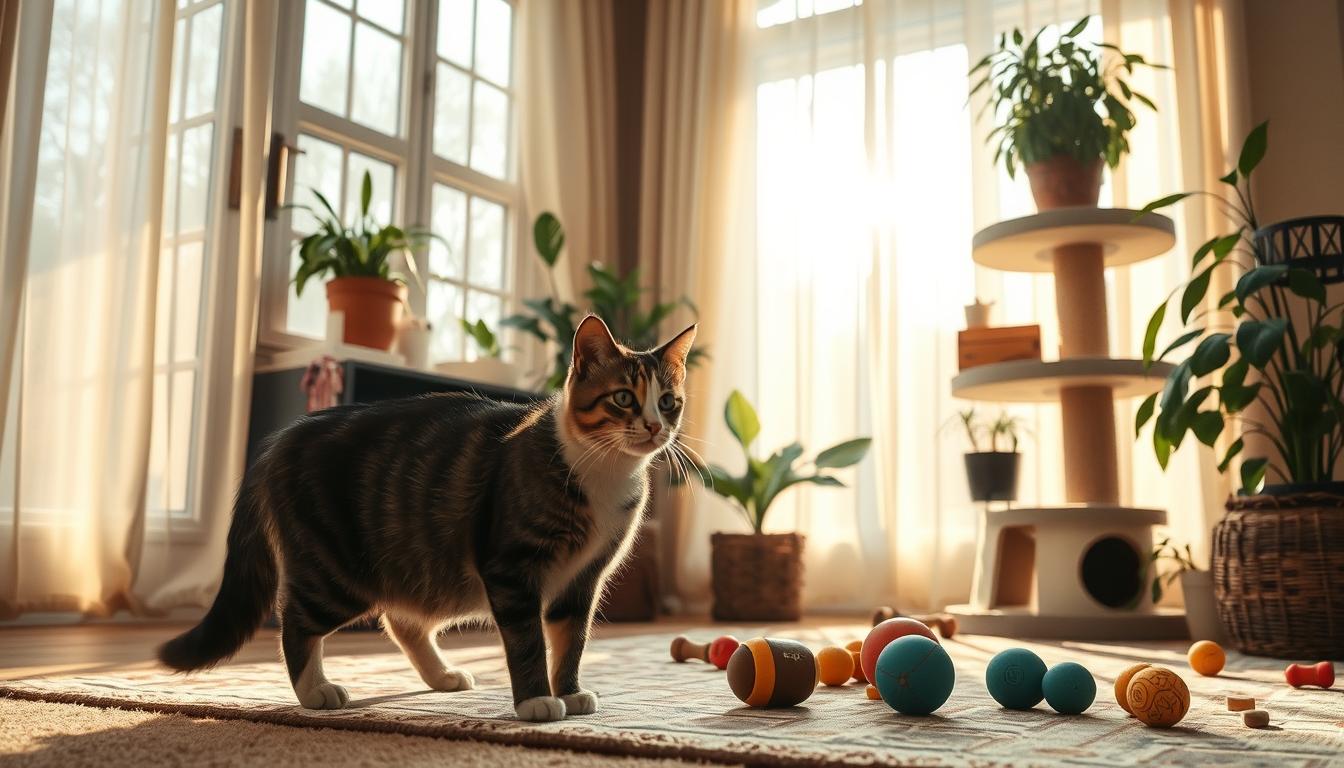As a devoted cat owner, keeping my furry friend safe is crucial. Cats are curious and adventurous, which can lead to danger. In this guide, I’ll share important cat safety tips to make a safe and cozy home for your cat.
Understanding your cat’s behavior and recognizing stress signs are key. We’ll also cover how to avoid household dangers. These tips will help you keep your cat safe and happy, whether you’re an experienced cat owner or new to pet care.
Let’s explore feline safety together. This way, your cat can live a happy and fulfilling life with you.
Understanding Your Cat’s Behavior
Being a cat parent means knowing how to read your cat’s behavior. It’s key for their happiness and your bond. By noticing their body language and stress signs, you can help them feel safe and comfortable.
Reading Feline Body Language
Cats show their feelings through body language. Watching their posture, ear position, tail, and face can tell you a lot. For example, a quivering tail might mean they’re anxious, while a slow blink shows they’re relaxed.
- Notice your cat’s ears: Up and forward means they’re calm and confident. Flat or back ears might show fear or anger.
- Look at their tail: A twitching tail can mean they’re upset. A slow swish shows they’re focused.
- Check their posture: A hunched cat might be stressed. A cat standing tall is likely happy and relaxed.
Recognizing Signs of Stress or Anxiety
Cats can get stressed or anxious for many reasons. Spotting these signs early helps you fix the problem and keep them happy. Some common stress signs include:
- Too much grooming
- Changes in eating habits
- More or less peeing or pooping
- Meowing or hissing more than usual
- Wanting to hide or not play
Understanding your cat’s behavior helps you create a loving home for them. Every cat is different, so it’s important to know what makes your cat special.
Creating a Cat-Friendly Home Environment
Making your home cat-friendly is key for your cat’s happiness and safety. Think about what your cat likes and needs. This way, you can make a cat-safe environment that meets their needs. Here are some tips to make your home a feline-safe home:
- Provide Adequate Vertical Space: Cats love to climb and perch, so install cat trees, shelves, or window seats that allow them to survey their territory from up high.
- Incorporate Hiding Spots: Felines feel more secure when they have access to cozy, enclosed spaces like cardboard boxes, cat carriers, or specialized cat furniture with hidden nooks.
- Encourage Physical Activity: Set up scratching posts, interactive toys, and cat-proof areas for your furry companion to engage in play and exercise.
- Establish Designated Zones: Designate specific areas for your cat’s food, water, litter box, and resting spots to create a structured and cat-proof house.
| Feature | Benefits |
|---|---|
| Vertical Spaces | Allows cats to climb, perch, and survey their environment, catering to their natural instincts. |
| Hiding Spots | Provides a sense of security and comfort, helping reduce stress and anxiety. |
| Physical Activity | Promotes mental and physical stimulation, preventing boredom and potential behavioral issues. |
| Designated Zones | Creates a structured and organized living space, making it easier for cats to navigate and feel at ease. |
By adding these features to your cat-friendly home, you can make a safe and fun space for your cat. A well-designed cat-safe environment keeps your cat happy and healthy. It also makes your home a better place for both you and your cat.
Ensuring Proper Nutrition and Hydration

Keeping your cat healthy means giving them the right food and water. Choosing the best cat food and making sure they have clean water is key. This helps your cat stay happy and healthy.
Choosing the Right Cat Food
Not all cat foods are the same. Look for ones that are full of nutrients and fit your cat’s needs. Think about their age, how active they are, and any health issues they might have. Always check with your vet to pick the best food for your cat.
Providing Clean Water Sources
It’s important for cats to drink enough water. Make sure they always have access to clean water. You can use several water bowls or a pet water fountain to make drinking more fun. Always clean and refill their water to keep it fresh and inviting.
| Nutrition Recommendation | Hydration Recommendation |
|---|---|
| Choose a high-quality, nutrient-dense cat food that meets your cat’s specific needs. | Provide clean, fresh cat water at all times and encourage hydration. |
| Consult your veterinarian for personalized cat nutrition recommendations. | Consider using a pet water fountain to keep the water clean and appealing. |
By focusing on proper cat nutrition and ensuring your cat has access to clean, fresh cat water, you can help support their overall cat health and well-being.
Cat Safety Tips

As a responsible cat owner, keeping your feline safe is key. We’ll cover essential cat safety tips to ensure a safe home for your pet.
Preventing Escapes and Wandering
Keeping your cat indoors is a big concern. Cats are curious and might try to go outside. This can be dangerous. To stop them from escaping, always keep doors and windows closed. You can also install screens or cat-proof windows.
Make sure your cat wears a collar with an ID tag. This is important in case they do get out.
Securing Household Items
Household items can be a risk for curious cats. Store chemicals, medications, and cleaning products safely. Keep them out of your cat’s reach. Also, watch out for cords, strings, and small objects that could be choking hazards.
Check your home regularly to make sure it’s safe for your cat.
Addressing Common Safety Concerns
- Remove any toxic plants or flowers that could harm your cat.
- Keep your cat’s litter box clean and easy to find. This helps prevent health problems.
- Watch your cat during playtime. Avoid leaving them with small toys or objects that could be swallowed.
- Consider microchipping your cat for extra safety in case they get lost.
By following these cat safety tips, you can keep your feline companion safe and happy. A safe home is crucial for your pet’s health and happiness.
| Safety Tip | Importance | Action Required |
|---|---|---|
| Prevent Escapes | Keeps your cat safe and prevents potential accidents or injuries | Install screens, keep doors and windows closed, ensure proper identification |
| Secure Household Items | Reduces the risk of your cat accessing hazardous materials or choking on small objects | Store chemicals, medications, and small objects in secure cabinets |
| Address Common Concerns | Promotes your cat’s overall health and well-being | Check for toxic plants, maintain litter box cleanliness, supervise playtime, consider microchipping |
By following thesecat safety tips, you can create a safe and loving home for your feline companion. Always put your cat’s safety and well-being first as a responsiblepet owner.
Keeping Your Furry Friend Indoors

As a pet parent, keeping your cat safe is a top priority. Keeping them indoors is key to avoiding dangers and creating a safe space for them to live happily. We’ll look at ways to stop them from escaping and wandering, so they can enjoy life at home.
Preventing Escapes and Wandering
Cats love to explore, which can sometimes lead them to try to get out. Here are some tips to keep your indoor cat safe:
- Install sturdy, secure screens on all windows and doors to prevent your cat from squeezing through open spaces.
- Teach your cat to associate the outdoors with negative experiences, such as the sound of a spray bottle or a loud noise, to discourage them from attempting to escape.
- Provide ample stimulation and enrichment inside your home, such as interactive toys, scratching posts, and perches, to satisfy your cat’s natural desire to explore and play.
- Ensure that all entryways, including balconies and patios, are secure and equipped with barriers to prevent your cat from slipping out.
- Consider microchipping your cat as an additional layer of protection, in case they do manage to escape your home.
By taking these steps, you can greatly lower the chance of your indoor cat getting lost or escaping. This keeps them safe and happy at home.
| Benefits of Keeping Cats Indoors | Risks of Letting Cats Outdoors |
|---|---|
|
|
Identifying and Avoiding Household Hazards
As pet owners, we must make our homes safe for our cats. Cats are curious and might get into trouble. We’ll look at common dangers and how to keep your cat safe.
Toxic Plants and Chemicals
Many plants and chemicals in our homes can harm cats. Lilies, azaleas, antifreeze, and cleaning products are examples. It’s important to know which items are dangerous and keep them away from your cat.
Replace harmful plants with safe ones like cat grass or catnip. This way, your cat can enjoy plants without risk.
Securing Potential Choking Hazards
Cats like to play with small things, which can be dangerous. Watch out for rubber bands, string, and small toys. Make sure they’re out of your cat’s reach.
Also, check your home for loose wires or cords. These can wrap around your cat’s neck. Keeping your home safe is key to your cat’s health and happiness.
Grooming and Nail Care Essentials
Keeping your cat clean is more than just looks. It’s key to their cat health and wellness. Regular cat grooming and cat nail care stop skin problems, matted fur, and health issues. As a pet owner, it’s vital to groom your cat right to keep them happy and healthy.
Establishing a Grooming Routine
Begin by getting your cat used to grooming. This includes gentle brushing, combing, and baths (if needed). It helps keep their fur shiny and clean. Be patient and make grooming a positive experience for your cat.
- Brush your cat’s coat weekly to remove excess hair and prevent matting.
- Bathe your cat as needed, using a mild, cat-safe shampoo.
- Trim your cat’s nails every 2-4 weeks to prevent overgrowth and potential injury.
- Clean your cat’s ears regularly to prevent infection and maintain good hygiene.
Addressing Nail Care Needs
Trimming your cat’s nails is crucial for their grooming and nail care. Long nails can hurt, get caught, and cause ingrown nails. Be careful and patient when trimming nails. If unsure, ask a groomer or vet for help.
- Invest in a high-quality nail trimmer designed for cats.
- Gently hold your cat’s paw and expose the nail, being careful not to cut the quick (the blood vessel inside the nail).
- Trim the nail just above the quick, taking care not to cut too short.
- Provide your cat with a treat and praise after each successful nail trim to reinforce the positive experience.
By focusing on cat grooming and nail care, you ensure your cat’s health. Regular grooming and nail trimming are key for their comfort and cat health and wellness.
Traveling Safely with Your Feline Companion
Going on a trip with your cat can be thrilling. But, it’s important to make sure they’re safe and comfortable. Getting ready for cat travel is crucial for a stress-free journey for both you and your pet.
Whether it’s a quick drive or a long move, teach your cat to like their carrier. Start by introducing them slowly and positively. This makes the carrier a cozy spot for your cat.
It’s also key to keep your cat safe while traveling. Make sure their carrier is secure in the car. Give them water and toys they know to calm them down. Watch out for dangers at your destination. These steps help your cat feel safe, even in new places.

